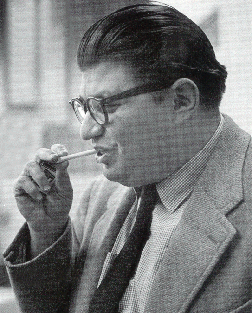|
The
Classical Music of the Twenty-First Century
by Don
Robertson
© 2000 by Don Robertson
<
Previous Page
Next Page >
Morton Feldman

I began to recognize the reality of the state of western
classical art music in 1967 while I was attending the Julliard
School of Music in New York and studying privately with the
late composer Morton Feldman. During the 1950s, Morty, as he
was known to his friends and students, was a member of John Cage’s circle, but by the
time I knew him, he had already broken with Cage. In reality,
Morty composed a different kind of music and had a completely
different aesthetic.
Every saturday morning, I took the Lenox Avenue subway to
Morty’s upstairs apartment in New York City to study with
him. We sat at the large grand piano in his front room
surrounded by large abstract paintings by his friends Franz
Kline, and Jackson Pollack. I would bring the
composition that I was currently working on and note by note,
Morty would go though my music and make suggestions and
comments, explaining how he created his famous chords and note
combinations.
My music at that time was completely under the influence of
Anton Webern, but I was daily becoming more influenced by the
music of Christian Wolfe, another member of the Cage group,
and Morty himself. The one record that I owned
of a Christian Wolfe piece was a musical composition that was
very sparse with a lot of space between the notes.
I used to listen to this record not at its intended 33 1/3 RPM
speed, but at the slower 16RPM, which created even more space and
sparsity of notes. Meanwhile, Morty was introducing me to his
own world of ‘quiet sounds’ and he spent many hours
showing me how he created his chordal combinations, stressing
the value of ‘each sound, each note.’
However, at the same time that I studied with Morty, I was
also studying with the great master of North Indian classical
music, Ustad Ali Akbar Khan. Khansahib, as his students called
him, had recently arrived in the United States and was
teaching five or six students in his New York apartment.
I found myself learning two different types of music at the
same time. I went to Khansahib to learn the deeply spiritual
ancient music of India, strongly based on the foundations of
natural scales, and to Morty to work on music that was based
on discords.
By 1968, my compositional technique had evolved to the
point of total rejection of any consonant musical intervals.*
My music by this time was based on the two most discordant
intervals in the scale: the tritone and the interval of the
minor second.** I had to work very hard when I composed to try
to get these intervals to influence the sound of the music and
to minimize hidden consonant intervals.
At first Morty had a difficult time accepting this
direction that I was heading in. He used the tritone and minor
second intervals all the time in his music, but he used
consonant intervals such as the minor and major third when he
felt they were appropriate, and so did other contemporary
composers such as Stockhausen and Boulez. To me, these had now
become mistakes. For Morty, my music was too sparse, and it
lacked something.
But one day, he turned to me and said, "You
have passed beyond John Cage and myself. And that is only
natural, since you are a part of the, next generation."
Once he had acknowledged what I was doing, I decided to
write an important composition in my new style. Morty helped
me in my selection of instruments. This piece would be for
bass clarinet, trumpet, celeste, guitar, violin, bass, and
percussion. I worked on it for a year.
As the year unfolded, I grew more and more frustrated
writing this composition--that I later named Last Piece--because
of the difficulty that I had in restricting the consonant
intervals. I could hear what I wanted in my mind, but creating
the music was an intellectual challenge because of consonant
relationships between intervals that could develop between
notes that were separated by other notes. I used to tell Morty
that what I really needed was a computer to help me compose
this music, but computers were not a commodity in 1969.
<
Previous Page
Next Page >
----------------------------------------------------------------------------------------------------
* A musical interval is
determined by the distance between notes.
** The tritone is the note that
divides the octave in half (i.e. the interval C-F#). It was
called the devil’s interval during the middle ages
and the renaissance and was avoided at all costs. The minor
second is the smallest interval of the scale. If you play the
notes E and F together at the same time, that is a minor
second.
|

